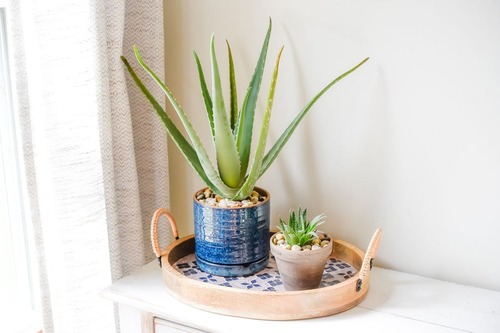Bathrooms tend to be one of the most humid spaces in a home due to constant exposure to water and steam from showers and baths. Excess humidity can lead to mold, mildew, and a generally uncomfortable environment. While dehumidifiers are one solution, plants can also play a significant role in helping to absorb moisture from the air. Not only do they reduce humidity, but they also improve air quality, add aesthetic value, and can thrive in the bathroom’s unique environment. Here are 6 best indoor plants that can help absorb humidity and add life to your bathroom.
1. Boston Fern

Boston ferns are one of the best plants for absorbing moisture in the air, making them ideal for humid spaces like bathrooms. They thrive in low light and high humidity environments, mimicking their natural habitat in tropical forests.
These plants absorb water through their fronds, helping to regulate moisture levels. With their lush, feathery fronds, Boston ferns bring a touch of greenery and elegance to any bathroom.
Care Tips:
- They can thrive in the lower light levels typical of many bathrooms, although they prefer bright, indirect light when possible.
- Place them near a window or in a well-lit area to ensure they get sufficient indirect sunlight.
- They need consistent moisture in their soil. Mist the plant regularly, especially during dry seasons.
2. Spider Plant

The spider plant is another excellent humidity-absorbing plant that is easy to care for and can thrive in bathroom conditions. Known for its air-purifying abilities, it helps improve indoor air quality while absorbing excess moisture.
They can absorb moisture through their leaves, making them effective in managing humidity levels. They are known to remove pollutants like formaldehyde, carbon monoxide, and xylene, which are often found in bathroom cleaning products. They can be grown in hanging baskets, allowing you to utilize vertical space in smaller bathrooms.
Care Tips:
- Keep the soil slightly moist but not soggy. Water when the top inch of soil feels dry.
- Spider plants prefer bright, indirect light but can tolerate low light conditions common in bathrooms.
3. Peace Lily

Peace lilies are renowned for their air-purifying properties and ability to thrive in high-humidity environments. Their broad, glossy leaves absorb moisture and they also release oxygen into the air, making your bathroom a fresher space.
They love the humidity, making bathrooms an ideal spot for them to thrive. They help remove toxins like ammonia, benzene, and formaldehyde from the air, which are commonly found in bathroom cleaning products. These plants are relatively easy to care for, requiring minimal attention while adding a serene, spa-like vibe to your bathroom.
Care Tips:
- Keep the soil consistently moist, but ensure good drainage to avoid waterlogging. Mist the leaves to replicate humidity.
- Peace lilies prefer low to medium light, so they’re well-suited to bathrooms with limited natural light.
4. English Ivy

English ivy is not only a beautiful vining plant but also an excellent option for absorbing excess moisture. It can be grown in a hanging basket or trained to climb along a trellis, making it a versatile addition to any bathroom.
It is efficient at absorbing moisture and can thrive in the humid conditions typical of bathrooms. It helps to filter mold spores, formaldehyde, and other airborne toxins, improving the overall air quality in your bathroom.
Care Tips:
- This plant can adapt to different light conditions, although it prefers bright, indirect light.
- Water moderately and ensure the plant doesn’t sit in water, as it prefers slightly moist but well-drained soil.
- English ivy thrives in bright, indirect light but can also tolerate low-light conditions found in many bathrooms.
5. Aloe Vera

Aloe vera is a popular succulent known for its medicinal properties, but it also works well in absorbing humidity in bathrooms. It is a hardy plant that thrives in humid environments while adding a touch of minimalist beauty to your space.
It can tolerate humidity, although it is more drought-resistant. It absorbs moisture through its thick, fleshy leaves. Aloe vera’s architectural form and soothing green color bring a modern, minimalist vibe to your bathroom.
Care Tips:
- This plant is easy to care for, requiring minimal watering and attention.
- Water sparingly, allowing the soil to dry out completely between waterings to avoid root rot.
- It prefers bright, indirect light. A bathroom window with sunlight is perfect, but it can also tolerate lower light levels.
6. Bamboo Palm

Bamboo palms are tropical plants that thrive in humid environments, making them a perfect choice for a bathroom. They can absorb excess moisture and also act as natural air purifiers, removing pollutants from the air.
These palms love moisture, helping to reduce excess humidity in the bathroom. They are effective at removing toxins such as formaldehyde, benzene, and carbon monoxide, commonly found in household cleaners. With their elegant, arching fronds, bamboo palms add a touch of the tropics to your bathroom while helping to balance moisture levels.
Care Tips:
- Keep the soil consistently moist, but ensure good drainage to prevent root rot.
- Bamboo palms prefer bright, indirect light but can tolerate low light, making them suitable for bathrooms with minimal natural light.
General Benefits of Indoor Plants in Bathrooms
Aside from helping to absorb humidity, these plants provide a range of benefits:
- Air Purification: Many bathroom plants help filter out airborne toxins, chemicals, and molds, improving overall air quality.
- Aesthetic Value: The lush greenery of indoor plants adds a calming and refreshing touch to bathrooms, turning them into more inviting, spa-like environments.
- Stress Relief: Studies have shown that being around plants can reduce stress and enhance mood, making your daily bathroom routine more pleasant.
- Natural Fragrance: Some plants, like peace lilies, can subtly freshen the air with their floral scent, eliminating the need for synthetic air fresheners.

